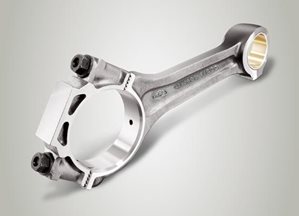Connecting Rods
Market leaders for commercial engine parts
 Connecting rods form the link between the crankshaft and the pistons and transfer the gas and inertial forces to the crankpins on the crankshaft. The connecting rod pushes and pulls the piston into and out of the cylinder.
Connecting rods form the link between the crankshaft and the pistons and transfer the gas and inertial forces to the crankpins on the crankshaft. The connecting rod pushes and pulls the piston into and out of the cylinder.- The small connecting rod eye on the piston side serves as a mounting for the piston bolt and is frequently equipped with a bronze connecting rod bearing bush.
- The connecting rods are mounted with connecting rod bearing shells on the crankshaft pins on the crankshaft. The large connecting rod eye is split to allow mounting on the crankshaft. To provide lubrication to the piston pins, connecting rods are frequently fitted with a drilled oil channel.
- Connecting rods are forged or cast from steel. Depending on the intended strain, alloyed or hardened and tempered steel may be used.
- Connecting rods must be replaced if they become fractured or bent or if the bearing holder on the rod has been damaged. Provided that the other connecting rods are not damaged, the connecting rods in utility vehicle engines can be replaced individually.